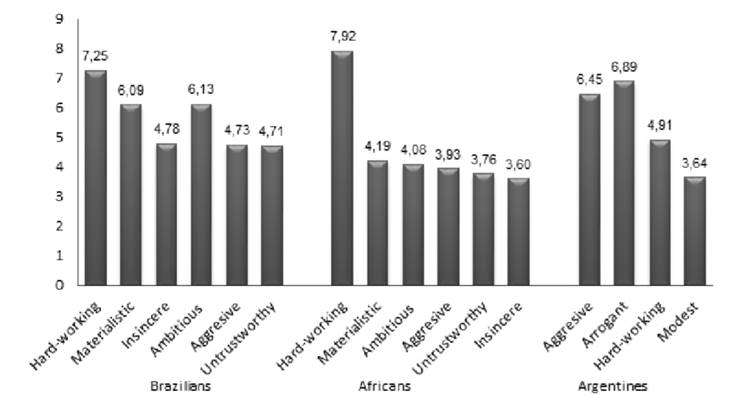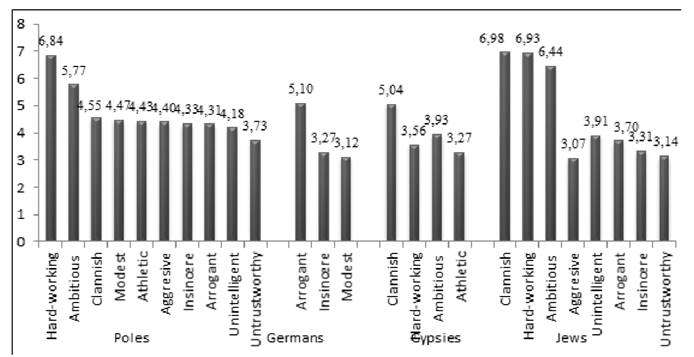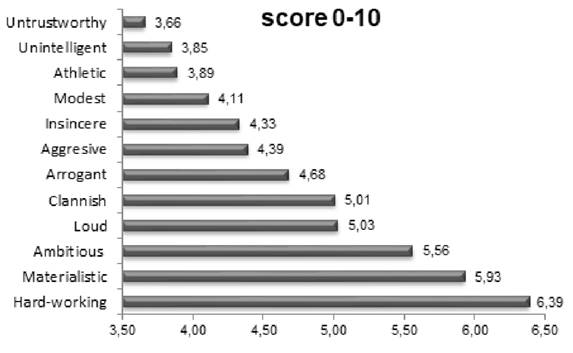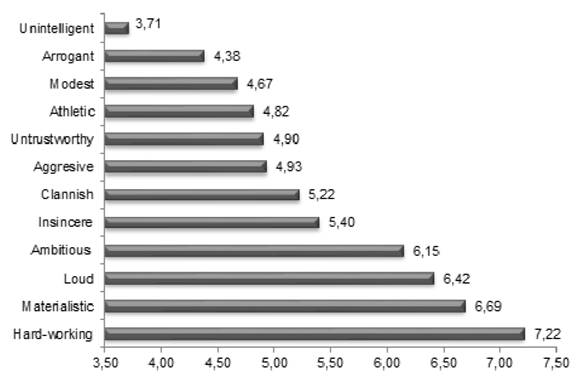INTRODUCTION
Fiske and Taylor (2013) identify 14 domains of social cognition, ranging from more basic concepts such as social attention, encoding of social stimuli and, social memory representations, to higher-order social processes such as social decision-making, social inference, attitudes, stereotyping and, prejudice.
Recently Mathew and Raja (2018) offer us this concept in a compiled way in view of the various concepts discussed in the last century. These authors argue that social cognition refer to structures of knowledge, the interpersonal processes of knowledge creation and dissemination (including the encoding, storage, retrieval and activation of social information).
In this sense, Fiske and Tablante (2015) define stereotyping as the cognitive component of bias, as category-based beliefs about a group that also involve affective-evaluative loading and behavioral tendencies. Other authors suggest that stereotypes are explicit, expressible, by definition, social cognitions referring to shared social knowledge in a given cultural context. The results support the notion that, in a given situation, the decision dynamics underlying the completion of IAT tasks adapted encompass not only what the individual is in the situation and what he/she has learned through socialization, but also the very features of the sensorimotor apparatus (Smeding, Quinton, Lauer, Barca & Pezzulo, 2016). These cognitive structures affect the encoding and processing of information, particularly information pertaining to out-group members (Dixon, 2000).
In this sense, the negative stereotypes generate a threat creating negative expectations about the conduct of members of an out-group. Stereotypes have for a long time, been associated with the negative attitudes of an out-group (Spencer-Rodgers & McGovern, 2002). Essentially, negative expectations influence both information and social judgment (Hamilton, Sherman & Ruvolo, 1990; Ybarra, Schaberg & Keiper, 1999). Stephan & Stephan (1996) postulated that because negative stereotypes represent negative expectations about the out-group, negative stereotypes appear together with negative emotions (e.g. fear, anger) towards the out-group that intensifies negative attitude of the out-group.
Koenig and Eagly (2005) argues that theorists describe stereotype threat as a state of self-evaluative threat, whereby anxiety about confirming a negative stereotype in others’ eyes, or in one’s own, produces conduct that is constant with and confirms the stereotype (Steele, Spencer & Aronson, 2002). Stereotype threat is habitually, explained as assimilation to a negative group-relevant stereotype through motivational processes (Wheeler & Petty, 2001). Theoretically, stereotype threat can occur to anyone with a group identity overladen with a negative stereotype, even if the group is historically, advantaged or of high status (Steele & Aronson, 1995).
Recent research has shown that ethno-political conflict impacts thousands of youth worldwide and has been associated with several negative psychological outcomes. For instance, analyzing ethnic variation in the development of negative stereotypes about ethnic outgroups among Palestinian, Israeli Jewish and, Israeli Arab, results indicate important ethnic differences in trajectories of negative stereotypes about ethnic outgroups, as well as variation in how such trajectories are shaped by prolonged ethno-political conflict (Niwa, et al., 2014).
Also, are positively, related to the other threats specified by the Integrated Threat Theory. Besides, similar to Stephan et al. (2002) found, negative stereotypes are shown to have both direct and indirect relationships with out-group attitudes. Although negative stereotypes have a moderate relationship with other threat types, they also maintain a direct, unique relationship with out-group attitudes. Complicating the issue further is the possibility that negative stereotypes may also be a result of intergroup threat. Various authors (Brewer & Alexander, 2002; Dovidio, Brigham, Johnson & Gaertner, 1996) have suggested that prejudice can be the cause of negative stereotypes as well as vice versa. If is exact, then it seems reasonable to assume that intergroup threats may create negative. Obviously, the role of negative stereotypes in future theories of intergroup threat needs, to be examined from multiple perspectives.
On the other hand, recent reviews show that both authoritarianism and social dominance had an indirect effect on moral exclusion mediated by negative stereotypes about the target group. This finding suggested that negative stereotypes were more important legitimizing factors for RWA than for SDO (Hadarics & Kende, 2018).
In this study, we analyse on negative stereotypes in two cultures with very different history and geopolitical context (but to some extent similar religion context) and different ethnic groups: Brazil and Poland. Recent studies have shown that the nature and persistence of socio-cognitive aspects, such as racism, discrimination and prejudice, and the multiple ways in which these can negatively impact the health of ethnic-racial groups, from access policies and practices to resources, negative stereotypes, sustained by cultural racism which promote psychological responses that are harmful to health (Ramos-Oliveira, Magnavita & Oliveira, 2017).
Previous studies suggest for example, that gender shapes identity processes, including the development of ethnic identities (Pahl & Way, 2006). Because women have traditionally been the bearers of culture, ethnic minority girls may suffer more thorough enculturation into their ethnic groups’ heritages, giving rise to higher levels and/or greater increases of affirmation and belonging during at any stage of life (Phinney, 1990; Rotheram-Borus, Lightfoot, Moraes, Dopkins & LaCour, 1998). Just as experiencing overt acts of discrimination is a powerful impetus for exploring the meanings and consequences of one’s ethnic group membership (Cross, 1991). That level of affirmation and belonging may increase in response to perceived prejudice and discrimination (Branscombe, Schmitt & Harvey, 1999; Schmitt, Spears & Branscombe, 2003). Similarly, the strength of the association between discrimination and ethnic identity may vary with the source of discrimination (Pahl & Way, 2006).
The goal of the present study is to provide a preliminary investigation how stereotypes reflect in the cognitive component of prejudicial attitudes in two cultures (Brazil and Poland).
METHOD
Design
The research uses the cross-sectional methodology. The data collection was carried out through questionnaires. The research kept the participants’ anonymity and confidentiality.
Participants
The participants came from careers in the area of Social Sciences and Humanities in the non-probabilistic sample. Collaboration and volunteerism was a very important factor in the whole process of the development of this study, both by the professionals involved and by the undergraduate students. The application of the questionnaire was carried out in the classroom. In the case of the University of Poland, the questionnaires were translated into the Polish language. To avoid having an overly heterogenous sample of undergraduate students in different countries, we recruited a sample in terms of careers in the area of Social Sciences and Humanities as well as age.
Four hundred fifty one students from Poland and Brazil participated in the study. The Brazilian sample consisted of 73.3 % female and 26.7 % male; Polish comprised of 77.2 % female and 22.8 % male, with ages ranging from 22 to 25 years, 25.58 (SD=6.83) in Brazil and Poland 21.79 (SD=2.92). Many of the participants from Brazil and Poland worked and studied at the same time (38 % in Brazil and 36.3 % in Poland). Regarding the marital status of the sample, 79.5 % of Brazilians were single, compared to 96 % in Poland.
Measure
Negative Stereotype Index (W. G.Stephan & Stephan, 1996)
To evaluate stereotypes as an aspect of social cognition, and in fact that negative stereotypes lead to feelings of threat. It has been suggested that negative stereotypes because perceived realistic threats, perceptions of value differences (Stephan et al., 2002). Were assessed by a 12-item scale asking participants to estimate the percentage of the out-group possessing each of 12 traits (e.g., hard-working, unintelligent, arrogant, aggressive, modest, athletic, ambitious, untrustworthy, insincere, materialistic, loud, clannish) on a 10-point scale ranging from 1 (0 %-10 %) to10 (91 %-100 %).
Brazilian evaluated intergroup (national) the African, Argentine and Portuguese, in addition to self-assess the national group.
Polish evaluated intergroup (exo) the Germans, Gypsies and Jews, in addition to self-assess (endo) to the Poles.
The instrument shows within its psychometric properties a level of reliability of .77 in Brazil and .78 in Poland in Cronbach alpha.
Procedure
The research protocol for this study was approved by the institutional review boards of the University of Basque Country where the author was during Phd. The choice of the groups follow pre-established criteria, for example, in Brazil and Poland that there were no foreign students in classrooms, but the work was adjusted to the possibilities of professionals in each country and their students to compose the sample. Participants received information about the study’s purpose, after during their regular classes was given a letter of informed consent that included issues of confidentiality and explained the objectives of the study and its implications. The confidentiality of participant data was said to be fulfilled through anonymity.
Data Analysis
Descriptive analyzes were performed. Student’s T-test was applied for independent samples in order to analyze statistically significant differences between the perception and self-perception of the Brazilian in-group towards other out-group (Africans, Argentines and Portugueses) in relation to negative stereotypes. In addition, with the perception of other ethnic groups, for example, the Poles towards the Germans, Gypsies and Jews was analyzed.
RESULTS
Perception of Brazilians in relation to negative stereotypes in different ethnic groups
Africans Brazilians point out that Africans do more Hard work t (52)= -2.156, p < .03, the average for Brazilians was 7.25 (SD=1.89) and 7.92 (SD=2.11) for Africans. However, Brazilian 4.71 (SD=2.0) score higher on the Aggressive stereotype t (55)=3.74, p < .001 than Africans 3.93 (SD=1.9) as well as on the Ambitious stereotype t (53)=6.06, p < .001 that is to say Brazilians (M = 6.13, SD = 2.47) are more ambitious than the Africans (M = 4.08, SD = 2.36).
It was also found that traits as Untrustworthy t (54)= 3.42, p < .001, Insincere t (54)= 3.69, p < .001 and Materialist t (53)= 5.54, p < .001, the Brazilians obtained a higher average compared with the Africans. The means found for the following stereotypes were as follows: Untrustworthy: Brazilians (M=4.71, SD=2.43), Africans Untrustworthy (M=3.76, SD=2.41); Insincere: Brazilians (M=4.78, SD=2.40), Africans (M=3.60, SD=2.50); Materialists: Brazilians (M=6.09, SD= 2.53) and for Africans (M=4.19, SD= 2.57).
Argentines When Brazilians were asked what negative stereotypes they would attribute to the Argentines, it was found that Brazilians 7.19 (SD = 1.76) consider that they perform more Hard work t (46) = 6.20, p < .001 than the Argentines 4.91 (SD = 2.53). But, they attribute to the Argentines (M = 6.89, SD = 2.25) to be more Arrogant t (45) = -5.08, p <.000 than Brazilians (M=4.67, SD=1.82); as they consider that Argentines are more Aggressive t (47)= -3.15, p < .003. Argentines have an average of 6.45 (SD=2.32) and Brazilians 5.13 (SD=2.14). Finally the Brazilians (M=4.87, SD=2.24) scored to be more Modest t (44)= 3.25, p < .002 that the Argentines (M=3.64, SD=2.58).
Portuguese In relation to the group of Portuguese, only consider that Brazilians (M = 7.18, SD = 2.18) do more Hard work t (48)= 7.51, p < .001 than Portuguese (M=4.95, SD=2.66). Figure 1 shows the information mentioned above.
Perception of Poles in relation to negative stereotypes in different ethnic groups
Germans When the Poles were asked how they perceived certain groups in stereotypical terms, they argued that the Germans are more Arrogant t (48)= -2.74, p < .009, obtaining an average of 4.31 (SD=2.03) or the Poles and an average of 5.10 (SD = 2.32) for the Germans. However, the Poles scored higher on the stereotype Modest t (48)= 4.00, p < .001 and Insincere t (48)= 4.21, p < .001 in relation to the Germans. With a mean of 4.47 (SD = 1.92) for the in-group and 3.12 (SD = 1.77) for the out-group in the Modest tract and a mean of 4.33 (SD = 2.10) and 3.27 (SD = 1.61) respectively for the stereotype Insincere.
Gypsies On the other hand, the negative stereotypes that the Poles (M = 6.84, SD = 1.56) self-attribute more than the Gypsies (M = 3.56, SD = 1.97) are to perform Hard-working t (44)= 9.42, p < .001. On the other hand, the Poles (M = 4.43, SD = 2.10) are rated as more Athletic t (43) = 2.86, p < .006 than Gypsies (M=3.27, SD=1.78). In addition the Poles (M = 5.77, SD = 1.98) are considered more Ambitious t (43)=5.35, p < .001 than Gypsies (M=3.93, SD=2.07). However, the Poles (M = 4.55, SD = 2.59) indicate that the Gypsies (M = 5.04, SD = 2.45) are Clannish t (44)= -7.09 p < .000.
Jews- Regarding negative stereotypes of out-group Poles describe them as people doing Hard-working t (44)= -2.49, p < .01, obtaining an average of 6.93 (SD = 1.80) compared the Poles that obtained 6.07 (SD = 1.90) as Ambitious t(42)= -3.23, p < .002 with a mean of 6.44 (SD = 2.36) compared to 5.05 (SD = 1.87) for the Poles. Students considered more Clannish t (44) = -4.66 p < .001 with a mean of 6.98 (SD = 2.31) to an average of 4.98 (SD = 2.68) of the Poles. Also, the Poles relative to the group of Jews were perceived as Unintelligent t (44)= 3.67 p < .001 with an average of 4.18 (SD = 2.24) compared to 2.91 (SD = 1.71) of the Jews as more Arrogant t (43)= 2.47, p < .01 with an average of 4.59 (SD=1.92) and 3.70 (SD=2.03) of Jews. As more Aggressive t (44)=4.47, p < .001, with 4.40 (SD = 1.72) versus 3.07 (SD = 1.68) of the Jews. Finally, the Poles were perceived as Untrustworthy t (43)=1.99 p < .05, that is, the Poles (M = 3.73, SD = 2.10) are considered to be untrustworthy in relation to the Jews (M=3.14, SD=1.86) and more Insincere t (44)=3.27, p < .002, since the Poles score higher in this characteristic (M=4.98, SD=2.68) in relation to the Jews (M=3.31, SD= 1.78).
In Poland, case groups analyzed were Poles (self-perception), Gypsies (Roms), Jews (Hebrews) and Germans. Polish students when asked how they perceived certain groups in stereotypical terms answered that Germans are the most arrogant. In terms of negative stereotypes, Polish students consider Gypsies to be the most clannish. Among groups analyzed in Poland, Polish student have the most negative stereotypes toward Jews. The most important traits for Jews were: persons performing hard-working, ambitious, clannish, unintelligent, arrogant, aggressive, untrustworthy and insincere (Figure 2).
Over the intergroup analysis performed for the T-test, we collected the following results: Poles are attributed as stereotypical adjectives of the national group: perform hard-working, materialistic and ambitious. To a lesser extent, the characteristics of loud and Clannish are attributed. They were rejected as attributes of the national group being Arrogant, Aggressive and Insincere and Modest. Likewise, the attributes of Athletic, Unintelligent and Untrustworthy were clearly rejected.
Of the twelve stereotypes presented, Brazilians attribute themselves primarily to characteristics such as Hard-work, Materialistic, Loud and Ambitious. Second, attributes such as Ambitious, Insincere and Clannish are attributed. In the third place the following characteristics are presented: Aggressive, Untrustworthy, Athletic and Modest. Finally, the stereotypical attributes that were attributed least were Arrogant and Unintelligent, which are shown in the Figure 3 and 4 respectively.
DISCUSSION
The results from this study provide further evidence about social cognition of stereotypes reactions toward outgroups. In line with our hypothesis, negative stereotypes generated through the creation of threat negative expectations regarding the behavior of the members of the outgroup. Stereotypes have long been associated with negative attitudes toward outgroup (Riek, Mania & Gaertner, 2006; Spencer Rodgers & McGovern, 2002). Corroborate also, with study of (Hadaricks & Kende, 2018) in their study with different ethnic groups like Muslim, Roma and Jewish, that indicating that the nexus within a motivated social cognition framework, showed that negative stereotypes related to the target groups are used as the justification for the motivated exclusionary practices. Consequently, the perception of the outgroup as violating the ingroup’s norms and values authorizes people to disregard moral concerns and responsibilities towards them. The results showed that the expectations about the outgroup, the negative stereotypes occur in conjunction with other negative emotions, which intensify negative outgroup attitudes.
The assessment of Argentines as little modest and aggressive, reproduces a negative stereotype about a group of equal or higher status - Argentines are perceived to do less hard-work. However, compared to a group of similar status and same language, such as Portuguese, no notable differences are perceived and accepted that only Portuguese people do less hard-work.
On the other hand, the Poles’ valuation of the Germans was like that of the Brazilians to do Argentines, or of a group of relatively superior status. That is to say, they considered the Germans as more Arrogant, sincere and less modest. To a group of lower status and marginalized like the gypsies, the Poles perceived them as doing little hard-work, less Ambitious, Athletic and more Clannish. Finally, they perceived the Jews, mainly as more Ambitious, doing more hard-work, and more Clannish, but also as rather more intelligent, less arrogant, less aggressive than the Poles. This positive stereotype of a previously persecuted group and in a context of certain cultural anti-Semitism, suggests a tendency to compensate in educated environments.
The logic of clear group favoritism, is relatively absent in the case of the European countries, dominating a self-critical logic and defensive acceptance of the status of a superior group in the case of the Poles in comparison with the Germans. Our study is consistent with the research in the context of teachers’ bias in grading immigrants and native children in middle schools, using IAT technique. Teachers give lower grades to immigrant students compared to natives who have the same performance on standardized, blindly-graded tests. For instance, math teachers with stronger stereotypes gave lower grades to immigrants compared to natives with the same performance (Alesina, Carlana, Ferrara & Pinotti, 2018). Likewise, with the classic studies presented by Fiske, Cuddy, Glick and Xu (2002) and Cuddy and Fiske (2003), a superior and competitive group like the Argentines and Germans, are perceived to be instrumentally superior but expressively unpleasant- Arrogant and little Modest. These findings corroborate with other studies that the negative stereotypical treatments attributed to an outgroup are more an unfavorable evaluation than consistent descriptions of positive or negative attributes (Stephan, Renfro, Esses, Stephan & Martin, 2001).
CONCLUSIONS
The negative stereotype traits in Poland and Brazil, found negative stereotypic traits attributed to an out-group resulted in more unfavorable evaluations than descriptions consisting of positive or positive and negative attributes. That stereotypic traits attributed by Brazilian and Polish to the other ethnic groups were more negative and rated higher. Although some of the treatment were attributed to own group members. For instance, in Poland (Figure 3) first group was more related between them, hard-working, materialistic and ambitious, the second group was linked be loud, clannish and arrogant. In addition, stereotypes that were related between them in Brazil (Figure 4), hard-working, materialistic, loud and ambitious, and we found a link between ambitious, insincere and clannish.
In both groups, and their antecedents were associated with negative out-group attitudes. However, is a more general and more important one - different groups of people may dislike each other for similar reasons. Many factors can increase the negative stereotypes about different target group, for example, as demonstrate (Kim, Harwood & Xiang, 2018) which found that exposure to a threat message about immigrants (compared with a nonthreat message) resulted in more support for punitive immigration policies. The effect of negative stereotypes on intergroup bias was smaller in the nonthreat message condition than the threat message condition.
Our study has obvious limitations, a sample mainly female and university. Undoubtedly, more data from national groups on negative stereotypes must be analyzed. We hope that future studies will shed more light on the sources and mechanisms of social cognition of the stereotypes as a mental representation that implies in the interpersonal relationship in the different ethnic groups.


















